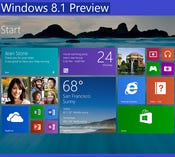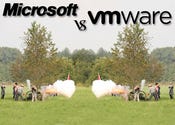Microsoft Build: From Windows 8.1 To XboxMicrosoft Build: From Windows 8.1 To Xbox
Windows 8.1 got its moment in the spotlight during Monday's Build keynote, but the real star was Microsoft's expanding ecosystem.


10 Hidden Benefits of Windows 8.1
10 Hidden Benefits of Windows 8.1 (click image for larger view)
As promised, Microsoft on Wednesday launched a public preview of Windows 8.1. Speaking to a developer-heavy audience of 5,000, CEO Steve Ballmer introduced the update during the opening keynote at the company's Build conference in San Francisco. The venue demanded attention not only to Win8, whose Modern UI has been the subject of much criticism and debate, but also to the wider Microsoft ecosystem to which developers now have access. Ballmer and other execs largely met this dual mandate by making Win8.1 one of only several major topics discussed throughout the keynote.
Other focuses included opening Bing as a development platform, empowering developers with new tools and creating a cohesive experience across the Windows ecosystem, from smartphones to desktops.
Anticipation was clearly high. An hour before the event started, the line of waiting attendees already stretched across two floors of the convention center, out the door, and onto the sidewalk, where the morning commute rushed by. Despite the crowds, many wondered whether Wednesday's keynote would actually divulge new information, given that Redmond had already confirmed and demonstrated the restored Start button and many of Win8.1's other tweaks.
[ Is Microsoft also planning to upgrade its organizational structure? Read Microsoft Reorg Rumors Heat Up. ]
The answer? Not really, as far as Windows 8.1 is concerned, though Microsoft execs charted new ground elsewhere. In terms of the OS update, Windows chief Julie Larson-Green took to stage mostly to review changes and enhancements that Microsoft demonstrated earlier this month at the Computex trade show in Taiwan. That said, some features -- particularly those that apply to smaller tablets, which Ballmer said he expects to thrive -- received new attention.
Larson-Green noted, for example, that when typing on most tablets' on-screen keyboards, auto-complete functions allow users to select among suggestions only by lifting their hands from the keys. This causes a break in the workflow, she argued, but Windows 8.1 corrects the problem, allowing users to choose the desired correction by sliding a hand across the space bar.
Larson-Green also previewed a version of PowerPoint for Windows RT, continuing the company's migration of its legacy software to the new platform. She also promised that all of the native apps in Windows 8.1 would be either updated or new. She also emphasized that apps are updated automatically, without user action, and that Windows 8 can instantly scale to different form factors, even resizing an application in real time as it was dragged from a tablet screen to an external -- and less pixel-dense -- monitor.
These are just a few of the many features with which Microsoft hopes to project a user-centric attitude that will help it gain traction among consumers and BYOD users. It remains to be seen if the public responds, but the updated OS appears substantially more user-friendly than the original edition. Many aspects of Larson-Green's presentation, such as animated backgrounds and improved multi-screen support for Modern apps, were familiar, but they still served to reaffirm how much Windows has changed since last fall.
Windows 8 was initially an attempt to retain Microsoft's core market of enterprise PC users while also muscling into the mobile market that iOS and Android dominate, and through which millions of iPads and other consumer devices have found their way into Windows' workplace turf. It was also an attempt to rally Microsoft's developers around new tools and new kinds of applications, and to create cohesion, for both users and programmers, across its ecosystem of products.
All of these efforts have struggled. Windows 8 hasn't revitalized PC sales, and tablets that run the OS are still afterthoughts compared to iOS and Android. Developers of traditional Win32 applications have also been hesitant to move to a new platform, and those that write for iOS or Android have been slow to add Win8 to the mix.
But things are changing. Microsoft touted touchscreens in the build-up to Win8's launch, but, as Ballmer conceded, few touchscreen devices were initially available. Now, OEMs have produced so many options that the CEO "doesn't know what kind of device to talk about." Standing in front of two tables full of Windows 8 devices, from smartphones to 27-inch mega-tablets, he concluded, "Windows devices of today look very different."
The new devices are also cheaper, as several presenters pointed out, and those with Intel's new Haswell chips offer better battery lives than devices that used previous-generation processors. Throw in the fact that smaller tablets will soon come bundled with Office, and the Windows landscape is, indeed, different.

VMware Vs. Microsoft: 8 Cloud Battle Lines
VMware Vs. Microsoft: 8 Cloud Battle Lines (click image for larger view and for slideshow)
Still, the PC landscape as a whole is different too. Businesses will remain largely invested in Windows for the foreseeable future, but tablets are eating into sales of conventional computers, and consumers have more flexibility than ever to choose which devices they want to use at work.
During the keynote, for example, each row in the press section featured a roughly equal mixture of OS X laptops and Windows 7 or 8 devices, as well as a menagerie of Android, iOS, BlackBerry and Windows Phone handsets. Microsoft once enjoyed a virtual monopoly over the computer market, but this new diversity demonstrates the crowded battlefield into which the company's new OS is treading.
To help make its offerings more appealing, for both business users and consumers, Microsoft needs the help of developers, and beyond Windows 8.1, much of Build was dedicated to these themes.
Bing VP Gurdeep Singh Pall demonstrated how new apps can harness the "unbounded knowledge" of the Internet by relying on Bing APIs, for example. Such apps won't simply bring up content like a traditional search engine, he said. Rather, they will include voice commands, rich graphics and 3-D imagery, all of which can be packaged to fit a certain form factor and to translate seamlessly across different devices.
VP of Web Services Antoine Leblond demonstrated an updated version of Visual Studio, meanwhile, that includes new diagnostics and debugging tools, among other resources. Leblond also teased upcoming applications involving 3-D printing.
Attention to Xbox games -- including Project Spark, with which Microsoft presenters built a game in a matter of minutes using a tablet -- rounded out the keynote.
In the end, nothing stood out in the flashy was that a new Surface might have -- but in a way, that might have been the point. Microsoft used to release huge products every few years. Now, the pace of innovation is much quicker, leading to models in which incremental updates are released frequently, and in which major changes arrive in small iterations, rather than massive overhauls. Windows 8 itself was a big change, but Microsoft execs claim that even before 8.1 was previewed, the OS had already received 800 updates. Don't expect paradigm shifts every few years, in other words, but rather a steady stream of small refinements.
Ballmer referred to a "rapid release" cycle as the "new norm for everything we do," and said it would be central to Microsoft's transformation "from software to software-powered devices and software-powered services."
In an interview at Build, Gartner analyst Carolina Milanesi said she was encouraged by much of the keynote.
"I wanted to hear about mobile, about phones all the way to the PC, that continuum," she said, adding, "That was obviously there."
She said that with Windows 8.1, Microsoft has "done everything they needed to, in terms of making the OS more engaging, and linking the familiar of the desktop with the Modern UI."
Though Win8.1's boot-to-desktop mode might encourage Win32 developers to ignore the new platform, Milanesi said she does not think this will be the case. The updated desktop mode includes more seamless and graceful connections to the Modern UI Live Tiles, and Milanesi said this will help desktop users to avoid forgetting the second UI is available.
Milanesi also noted that Microsoft seems "more attentive to the perspective of the user," and that the Windows Store, with its emphasis on merchandising applications, gives developers incentive to produce new apps.
After stumbling out of the gate, then, Microsoft's modern ecosystem is coming into shape. While it might not have presented anything revolutionary at Build, it passed an important test in terms of showing its responsiveness. The next test will be whether consumers start buying more Win8 devices.
About the Author
You May Also Like






